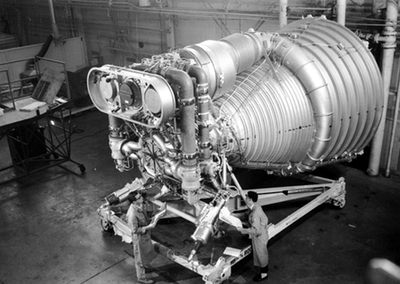A new hydrocarbon engine for America?by Anthony Young
|
| The first thing we can learn from the F-1 program is that it was adequately funded. A great deal of money was spent to ensure reliability and smooth combustion. |
Notwithstanding the fact that solid rocket motors (SRMs) have proven themselves for over a quarter of a century during the shuttle program, NASA sees the need to develop a new hydrocarbon liquid propellant rocket engine to be used in a clustered first stage application. Hydrocarbon refers to kerosene and would be used with liquid oxygen. Space News reported back in February, quoting from NASA documents, that the space agency “will focus on development of a U.S. core stage hydrocarbon engine” and that “a strong candidate [would be] capable of generating high levels of thrust approximately equal to or exceeding the performance of the Russian-built RD-180 engine.”
The RD-180 powers the current Atlas 5. According to the Pratt & Whitney Rocketdyne (PWR) website, this engine generates nearly one million pounds of thrust. So why not use this engine? Because, in part, the RD-180 is a product of a partnership between NPO Energomash of Khimki, Russia and PWR. The two-chamber RD-180 is an evolved design from the four-chamber RD-170 used exclusively on Russian launchers. It is clear NASA would like to have a completely American engineered and built high-thrust hydrocarbon rocket engine for its heavy lifter. At the same time, this apparently pushes aside proposals for using hydrogen-fueled engines like the Space Shuttle Main Engine (SSME) and RS-68 that had previously been planned at various times for the Ares 5.
Lessons from the F-1 engine program
The cluster of five F-1 engines, which powered the first stage of the Saturn 5 rocket, really needs no introduction to readers of The Space Review. It was the most powerful rocket engine ever built by any nation, and worked with utter reliability during Apollo and Skylab. The topic of reviving this superb engine has been raised over the years, primarily in discussions on Shuttle variants and in design proposals for a Saturn V-class new heavy lift launch vehicle.
Rocketdyne did, in fact, build several working F-1A engines as a more powerful evolution of the F-1 but was never employed as Congressional interest in Apollo waned and plans for moving beyond the Moon were shelved. When the design proposals for the Ares 5 were released by NASA, the F-1 engine was nowhere in the mix as the liquid propellant booster engine. Instead, the SSME was selected, and later replaced by the RS-68.
With the announcement of renewed liquid propellant hydrocarbon engine research by NASA for a future heavy-lift launch vehicle, what lessons from the F-1 engine program can be brought to bear on this new program to reduce design and development time?
| Many lessons learned from the F-1 program have been preserved by PWR and this knowledge base should wisely be applied toward any new rocket engine program. |
The first thing we can learn from the F-1 program is that it was adequately funded. Research and development money for the F-1 initially came from the Air Force during the late 1950s. Later, NASA enjoyed the favor of Congress and virtually all aspects of the manned Mercury, Gemini, and Apollo programs were generously funded. This included the F-1 engine program, after its transfer to NASA. When the problematic issue of combustion instability reared it ugly head during the F-1 program, no resource was spared to resolve the problem. A great deal of money was spent to ensure reliability and smooth combustion. Also, quality control during all phases of manufacture contributed to the F-1’s superb operational performance.
The second lesson from the F-1 program was that the engine was sized to meet massive payloads. The baseline thrust demanded by the Air Force when Rocketdyne initiated the program was one million pounds of thrust. After the program was transferred to NASA, the trust requirement was upped to 1.5 million pounds of thrust. Rocketdyne was able to do this without scaling up the engine but making the necessary modifications to the engine to increase propellant flow.
The third point is actually hindsight. The F-1 engine is half a century old. Even if the F-1 engine program was restarted, the engine would still have to undergo the same methodical development and durability testing. There have also been countless advances in metallurgy and manufacturing processes that can be used on any new hydrocarbon rocket engine. However, that does not mean development time would be any less, even with the most sophisticated CAD and finite element analysis programs currently available. Quite possibly a smaller engine with equivalent thrust to the F-1 could be engineered.
Finally, many lessons learned from the F-1 program have been preserved by PWR and this knowledge base should wisely be applied toward any new rocket engine program. Although the research and development of this engine would likely take place at the Propulsion Research Laboratory (PRL) at Marshall Space Flight Center, the only credible builder of such an engine in America would have to be PWR.
The one disquieting fact in all this is it will be years before America sees any fruit from this essential work in development of a new high thrust hydrocarbon engine for a yet to be designed heavy lift launch vehicle. Kennedy Space Center will be disturbingly quiet until this new engine thunders to life and America once again sends a heavy-lift launch vehicle from Launch Complex 39 into space.
